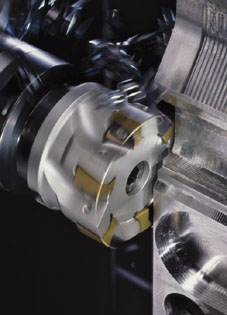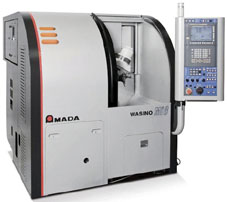 Milling is the process of cutting away material by feeding a workpiece past a rotating multiple tooth cutter. The cutting action of the many teeth around the milling cutter provides a fast method of machining. The machined surface may be flat, angular, or curved. The surface may also be milled to any combination of shapes. The machine for holding the workpiece, rotating the cutter, and feeding it is known as the milling machine.
Milling is the process of cutting away material by feeding a workpiece past a rotating multiple tooth cutter. The cutting action of the many teeth around the milling cutter provides a fast method of machining. The machined surface may be flat, angular, or curved. The surface may also be milled to any combination of shapes. The machine for holding the workpiece, rotating the cutter, and feeding it is known as the milling machine. Classification of milling
● Peripheral Milling
In peripheral (or slab) milling, the milled surface is generated by teeth located on the periphery of the cutter body. The axis of cutter rotation is generally in a plane parallel to the workpiece surface to be machined.● Face Milling
In face milling, the cutter is mounted on a spindle having an axis of rotation perpendicular to the workpiece surface. The milled surface results from the action of cutting edges located on the periphery and face of the cutter.● End Milling
The cutter in end milling generally rotates on an axis vertical to the workpiece. It can be tilted to machine tapered surfaces. Cutting teeth are located on both the end face of the cutter and the periphery of the cutter body.Methods of milling
● Up Milling
Up milling is also referred to as conventional milling. The direction of the cutter rotation opposes the feed motion. For example, if the cutter rotates clockwise, the workpiece is fed to the right in up milling.
● Down Milling
Down milling is also referred to as climb milling. The direction of cutter rotation is same as the feed motion. For example, if the cutter rotates counterclockwise, the workpiece is fed to the right in down milling. The chip formation in down milling is opposite to the chip formation in up milling. The figure for down milling shows that the cutter tooth is almost parallel to the top surface of the workpiece. The cutter tooth begins to mill the full chip thickness. Then the chip thickness gradually decreases.Milling equipment
The milling machine is one of the most versatile machine tools in existence. In addition to straight milling of flat and irregularly shaped surfaces, it can perform gear and thread cutting, drilling, boring and slotting operations which are normally handled on machine tools designed specifically for these specific operations. Milling machines can be broadly classified into the following types:
● Column Knee type milling machines
Used for general purpose milling operations, column and knee type milling machines are the most common milling machines. The spindle to which the milling cutter is may be horizontal (slab milling) or vertical (face and end milling).● Bed type Machines
In bed type machines, the work table is mounted directly on the bed, which replaces the knee, and can move only longitudinally. These machines have high stiffness and are used for high production work.● Planer Machines
Planer machines are similar to bed type machines but are equipped with several cutters and heads to mill various surfaces.● Rotary Table Machines
Rotary table machines are similar to vertical milling machines and are equipped with one or more heads to do face milling operations.● Tracer Controlled Machines
Tracer controlled machines reproduce parts from a master model. They are used in the automotive and aerospace industries for machiniAir Jordan













